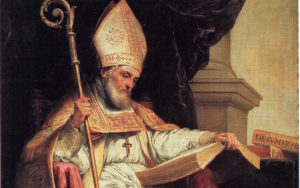From the Margins
The Internet’s Unofficial Patron Saint
What could someone who died 1,385 years ago have to say to us about the internet and the spread of disinformation?
 I sometimes feel that the internet turns me into a drugged-up lab rat who constantly scrolls and checks in throughout the day, sorting through random heaps of texts and images as if it were my job, except I’m not currently employed to do this for any company. On an intellectual level, I can understand documentaries like The Social Dilemma, which explain how the technology I use was built to be addictive. But I don’t want to miss breaking news or some crucial piece of information. So I jump on the wheel and I spin.
I sometimes feel that the internet turns me into a drugged-up lab rat who constantly scrolls and checks in throughout the day, sorting through random heaps of texts and images as if it were my job, except I’m not currently employed to do this for any company. On an intellectual level, I can understand documentaries like The Social Dilemma, which explain how the technology I use was built to be addictive. But I don’t want to miss breaking news or some crucial piece of information. So I jump on the wheel and I spin.
I’ve tried to dial it back for the sake of my sanity. Within the past year, I’ve cut down my hours on social media, limited my subscriptions to a few publications that I trust and enjoy, and relied on a handful of newsletters that curate content into my inbox. The irony is that I’m a writer who also puts out content and fervently hopes that out of the 16k people who liked and shared someone else’s platitude-meme, at least four might read through my essay. It’s rough out here in this attention economy! There’s pressure to constantly consume and perform. I’ve started listening to self-help podcasts that guide me to slow down. When I discovered — while randomly scrolling — that internet users have a designated spiritual protector from the 6th century, I decided: Why not look into this as well? Maybe the story of this information organizer from late antiquity could still have some relevance?
Isidore of Seville, the internet’s unofficial patron saint, was born around 560 CE. By all measures, Isidore, whose feast day is on April 4th, is an odd saint. He isn’t known for great miracles, acts of charity, or a dramatic personal life. Yet since the 1990s, several Catholics have looked to this Spaniard as a spiritual guide for navigating web surfing — or scrolling, as more people describe it today — and they sparked rumors that Pope John Paul II had officially elevated him to a patronage role. For Catholics, a patron saint is someone who provides heavenly intercession for a particular craft, group of people, or nation: St. Joseph for carpenters, St. Thomas Aquinas for academics, St. Rosa of Lima for Peru.

Carlo Acutis (Photo: Acutis family)
In 2020, the Catholic Church beatified (a preliminary step for sainthood) Carlo Acutis, another candidate for official internet patronage. Acutis, who is credited with performing a miracle in Brazil involving the healing of a 4-year-old boy with pancreatic malformation, was an Italian computer programmer and devout Catholic who died of leukemia in 2006 at the age of 15. Pope Francis declared that Acutis used the internet to “communicate values and beauty.” If Acutis does indeed become the Catholic Church’s first millennial saint and its official patron saint of the internet, this could be seen as an attempt by the Church to relate its faith to the day-to-day realities of contemporary Catholics.
Since I don’t consider myself a devout Catholic and I don’t necessarily believe in traditional saints, I have no stake in whether the Church officially elevates Isidore or Acutis as the patron saint of the internet. But as an internet user and as someone who came of age alongside the explosion of social media, I can appreciate things that provide perspective or distance to these pieces of technology that make me feel hyper-connected, lonely, and overwhelmed. In my case, I confess that I’m more intrigued by the decision of some Catholics to turn to Isidore than I am by a millennial computer programmer prodigy. What could someone who died 1,385 years ago possibly have to say to us? As I looked more into Isidore, I realized that his selection was apt in multiple ways. If there’s one figure in late antiquity credited for attempting to collect all of the world’s knowledge and preventing it from slipping into the oblivion of the so-called “Dark Ages,” it is Isidore of Seville, and his information age can still illuminate our own.
The “Wikipedia” of the Middle Ages
Isidore lived after the collapse of the western Roman Empire, in a Spain transitioning from Roman province to rule under the Visigoths. There are a few things that can be firmly established about his life. Isidore was born in the city of Cartagena to Hispano-Roman parents of high rank who fled to Seville after Byzantines invaded. His parents died while he was young, and he grew up with three talented siblings, including an older brother, Leander, who became a bishop and famously converted multiple Visigothic kings from Arian Christianity to Nicene Christianity. After Leander’s death, Isidore took over as bishop of Seville in 600 CE. He kept this post until his own death in 636 CE, presiding over Church synods and expanding the education of clergy during his tenure.
In the longer arc of history, Isidore has enjoyed strong audience engagement. He wrote one of the most widely-used textbooks throughout the Middle Ages. In Paradiso, the Italian poet Dante Alighieri put Isidore in the good place. For soccer aficionados cognizant of La Liga, Isidore can be spotted in his episcopal robes on the crest badge of Sevilla FC. There’s even an organization called the Order of Saint Isidore of Seville devoted to promoting Christian chivalry on the internet. It has a prayer to Isidore stating, “. . . during our journeys through the Internet we will direct our hands and eyes only to that which is pleasing to Thee and treat with charity and patience all those souls whom we encounter.” An earnest reminder to those of us struggling with casual onsets of jealously and rage as we scroll through Instagram and Twitter.

A 1655 painting of Isidore of Seville by Bartolomé Esteban Murillo
A 1655 painting by Bartolomé Esteban Murillo depicts a white-bearded Isidore in his bishop’s hat, hypnotically staring at a large book on his lap while seated next to other tomes. This rendition rings true for someone admired by contemporaries for his intellectual breadth. Isidore cemented his legacy through his research and literary output, bridging divides between the Hispano-Roman and Visigothic worlds. Among more than twenty works, Isidore published History of the Goths, which portrayed these “barbarians” in a more favorable light. According to punctuation expert Florence Hazrat, Isidore also invented the period, comma, and colon as we know them today. In terms of organizing texts and making them more readable this was huge we may take it for granted but this was in its own day the best thing next to the invention of spaces between words so if you have benefitted from modern grammar make sure to say this THANKYOUISIDORE
Isidore’s crowning achievement was The Etymologies (also known as The Origins). A sprawling encyclopedia written in accessible Latin, it covers a dizzying array of topics: all of the parts of speech, iron tools used in surgery, harmony and rhythm in music, the difference between natural and civil law, the Son of God, paneled ceilings, angels, tiny flying animals, the course of the stars, ship construction, upper eyelids, prophets, and chairs. Isidore intended it as a reference book for anything that clergy possibly needed to know, providing “SparkNotes” on various figures such as Aristotle and Cicero. Monks who later used The Etymologies sometimes changed Isidore’s ordering, scandalized that the work started with the liberal arts and not God. On one page, Isidore could be analyzing the books of the Bible and then swiftly transition to the history of libraries in Rome.
By understanding the roots of words, Isidore believed one could learn a great deal. For example, he says that penitence (poenitentia) overlaps with punishing (punier) because “they who truly do penance do nothing other than not permit what they have done wrong to go unpunished.” In a more playful entry, Isidore says: “Wine (vinum) is so called because a drink of it speedily replenishes the veins (vena) with blood. Some call it Lyaeus, because it loosens (solvere) us from care.” Many of the entries in The Etymologies still resonate. Isidore describes pestilence as “a contagion that as soon as it seizes on one person quickly spreads to many. It arises from corrupt air and maintains itself by penetrating the internal organs.” Other entries are inaccurate or badly dated: “All diseases come from the four humors, that is, from blood, bile, black bile, and phlegm.” Some topics are downright strange. In a long section on heresies, Isidore defines the “Nicolaites” sect as those following deacon Nicolas who “abandoned his wife because of her beauty, so that whoever wanted to might enjoy her; the practice turned into debauchery, with partners being exchanged in turn.” Today, some might call this, depending on one’s sexual ethics, swinging or pulling a Jerry Falwell, Jr.
Preserving Homo Sapiens
What can Isidore’s work suggest to us in our time? On the one hand, he evades any of our rigid religious/secular divisions of knowledge. The Etymologies are equally curious about worldly affairs as they are about divine matters. On the other hand, Isidore highlights the potential dangers of summarizers. Isidore wasn’t the first encyclopedist. He relied, rather unoriginally, on other proto-Wikipedia compilers such as Varro, Pliny the Elder, and Lactantius as sources for his work. Isidore translated the knowledge of the classical Greeks and Romans for Christians in a way that, intentionally or not, turned the philosophers he engaged into victims of his own success. Many Christians stopped copying the “pagan” works that he cited and read only Isidore instead. This fueled echo chambers of Christians reading about non-Christians and the past solely through the lens of Christian summaries, akin to learning about someone strictly through YouTube explainers made by their opponents.
Like algorithms constructed by humans, encyclopedias contain, for better and for worse, the prejudices of their makers. In The Etymologies, Isidore writes: “The name ‘Jew’ (Iudaeus) can be translated as “confessor” (confessor), for confession (confessio) catches up with many of those whom wrong belief possessed earlier.” The Fourth Council of Toledo, held in 633 CE and over which Isidore presided as bishop, passed anti-Jewish canons including one forbidding all Jews, and Christians of Jewish ancestry, from holding public office. King Ferdinand and Queen Isabella’s decision to expel Jews from Spain in 1492 could plausibly be construed as the repercussions of a larger disinformation campaign stretching back to Isidore.
Speaking of disinformation, I, myself, struggled with this dynamic in the process of writing this essay. How do you know if something is true? If enough people share the same thing, does that make it true? Based on my internet searches, I initially thought that Pope John Paul II had, in fact, made Isidore the official patron saint of the internet. But upon further investigation, this turned out to be a rumor that, nevertheless, got picked up by The Atlantic, CNN, Gizmodo, and several Catholic sites such as Catholic.net. If scribe after scribe copies a falsehood or an error in a text, it eventually gathers the weight of consensus.
The problem in Isidore’s day was scarcity of information. Our problem, we like to say, is too much information. We have access to more at our fingertips than the ancients could have ever dreamed of. And yet, it’s easy to deceive ourselves. People believe in conspiracy theories today that are as wild as the most outdated entries in The Etymologies. All of Google’s digital scrolls, including most of your online documents, photos, and memories are stored in physical locations, in data centers containing servers subject to the whims of nature, the planet’s climate, or human attack. The truth is that even our cloud systems are mortal, like the papyri that burned in the library of Alexandria. History reminds us that the transmission of our species’ knowledge, along with empathy, isn’t a given but a continual – and vulnerable – task.
Daniel José Camacho is a columnist for the Revealer. He has previously been a contributing opinion writer at the Guardian and an associate editor at Sojourners. Writing with a focus on religion, race, and history, his work has appeared in publications such as Religion News Service, America Magazine, ABC Religion & Ethics, TIME, and the Washington Post.